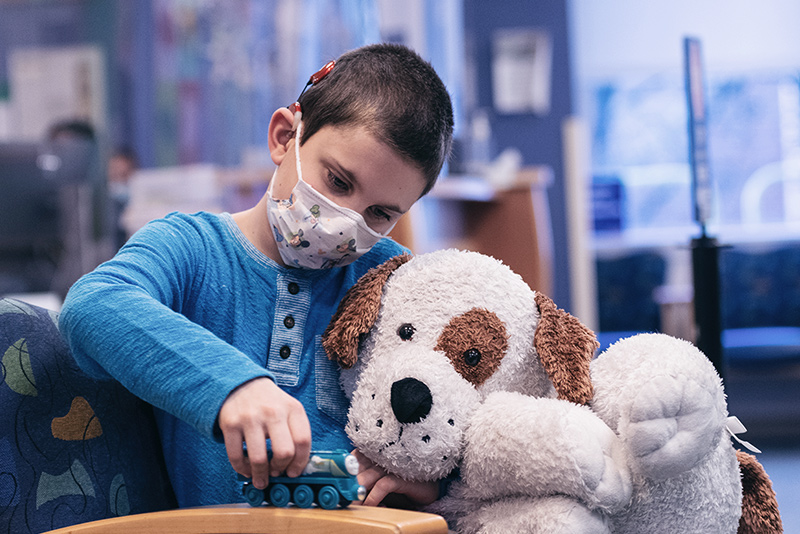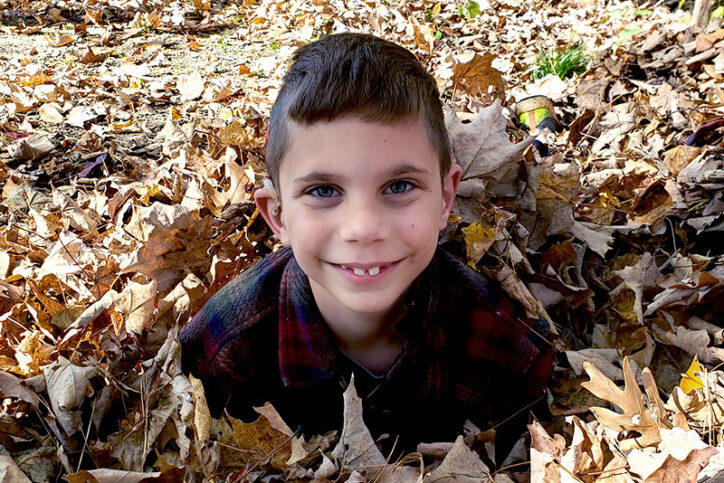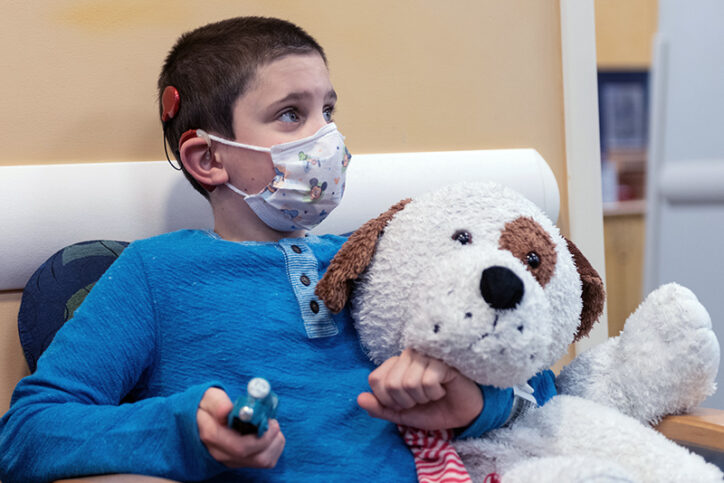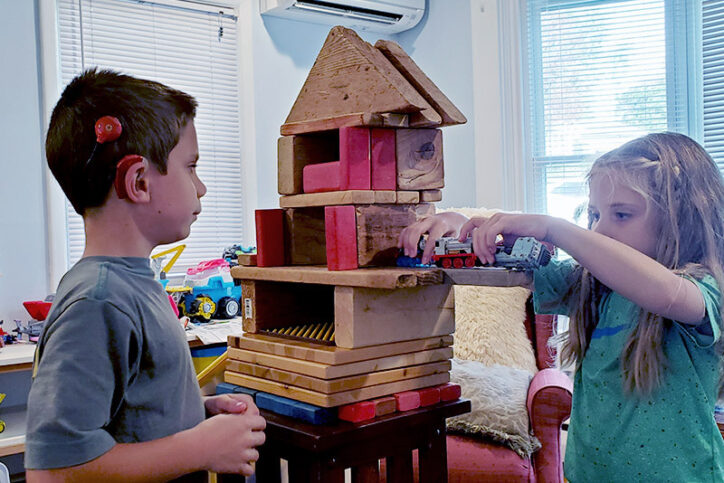A different kind of hearing: Caleb’s cochlear implant

Caleb recently told his mother, “I think I’m going to write my own stories.” This news didn’t surprise his parents, Wendy and Chris. For several years, 8-year-old Caleb has filled notebook after notebook with pictures and stories. His stack of favorite books includes Boxcar Children and The Chronicles of Narnia. But given some of his early setbacks, it wasn’t always clear that Caleb would grow to love language.
Born three months premature, Caleb was diagnosed with significant hearing loss in his right ear. At 8 months old, he started wearing a hearing aid, but its limitations became clear as he learned to speak. On hearing tests, Caleb could only recognize 5 percent of words with his right ear.
“The hearing aid helped him hear noise, but it wasn’t helping him understand language,” says Chris. Because he could hear out of his left ear, however, Caleb didn’t qualify for a cochlear implant, a surgically implanted hearing device with an external speech processor.
The FDA approves cochlear implants for unilateral hearing loss
For decades, people assumed that hearing out of one ear was enough. But a growing body of research has linked unilateral hearing loss to developmental issues. These include speech and language delays, behavioral problems, and academic underachievement.
The hearing aid helped him hear noise, but it wasn’t helping him understand language.”
In 2019, when Caleb was 5, the Food and Drug Administration approved cochlear implants for unilateral hearing loss in children 5 years and older. The Cochlear Implant Program at Boston Children’s Hospital was one of the few programs in the country offering cochlear implants for children like Caleb, those with significant hearing loss in one ear.
Weighing the pros and cons of a cochlear implant
Wendy and Chris took time to learn everything they could about cochlear implants before deciding to move forward. They had lengthy conversations with each other and the cochlear implant team in the Department of Otolaryngology and Communication Enhancement.
A cochlear implant would not “fix” Caleb’s hearing. He would wear a speech processor behind his ear that would translate sounds into electrical signals. These signals would be transmitted to the hearing nerve in his brain, but they would be different from the sounds he heard with his left ear. Could he learn to recognize the unfamiliar signals as words?

“We had to consider the possibility that it wouldn’t work,” says Wendy. “We didn’t know if his brain would learn to process the new information.”
They also had to consider the fact that Caleb has autism spectrum disorder (ASD), a neurodevelopmental condition that makes communication and social interactions difficult. Would a cochlear implant help him communicate? Or would ASD interfere with his brain’s ability to adapt to the new signals?
Yet there were compelling reasons to give a cochlear implant a try. Significantly, Caleb has a malformation in his right ear that could eventually lead to hearing loss in both ears. “If that does happen, he will have had time to learn how to function with at least one cochlear implant,” says Wendy.
“We saw the potential for huge gains,” says Chris. “If his word recognition weren’t so bad, we might not have taken the risk.” Being able to decipher language out of his right ear, his parents hoped, could help him both in school and social situations. They decided to move ahead.
Learning to listen with a cochlear implant
Caleb had cochlear implant surgery in September 2020. Dr. Jacob Brodsky placed a small receiver under the skin behind Caleb’s right ear and threaded a thin wire into his cochlea, a spiral structure in the inner ear. The procedure took about three hours.
A month after his surgery, Caleb’s audiologist, Dr. Jennifer Harris, activated the speech processor. With Caleb’s input on what he was hearing, Dr. Harris programmed the device specifically for his hearing needs. From there, Wendy and Chris went to work helping Caleb adapt to his new device.

Every day, Caleb’s parents read to him and lead him through exercises. He also has regular visits with Dr. Harris, who continues to fine tune his sound perception, and Zoom sessions with speech-language pathologist Nicole Salamy. Using Bluetooth to transmit her voice through the implant, Salamy leads Caleb through a series of language exercises.
“Nicole has a great rapport with Caleb,” says Wendy. “He can get frustrated doing the exercises with me, but he looks forward to seeing Nicole.”
Hearing out of both ears
Slowly but surely, Caleb has learned to translate signals from the cochlear implant into words, sentences, and full stories. Compared to his original 5 percent word recognition with a hearing aid, Caleb now recognizes 68 percent of words through his right ear — and continues to improve steadily.
We really think it helps him in school. He can hear his teacher and better navigate background noise.”
“We really think it helps him in school,” says Wendy. He can hear his teacher and can better navigate background noise. He also has an easier time hearing and understanding his classmates. “He can hear kids talking to his right. Before, he just didn’t understand anything coming from that side.”
However, says Chris, parents considering a cochlear implant need to know what they’re getting into. He stresses the importance of finding a center that offers comprehensive rehabilitation after the surgery. “A cochlear implant is not a minor thing. We needed to commit to two years of hard work and regular appointments at Boston Children’s to make this successful.”

Dreams of steam trains
Asked about his favorite things, Caleb reaches for pen and paper and draws a steam train. He has built miles of intricate track systems in his family’s finished basement. He dreams of taking an overnight trip on a steam train someday. In the meantime, he conjures the trip through drawings, personal track designs, and his new-found love of writing.
Learn more about the Department of Otolaryngology and Communication Enhancement and Cochlear Implant Program.
Related Posts :
-

‘Empowered to be there for Teagan’: New parents learn about hearing loss
Teagan O’Brien is a bright, spunky 4-year-old who loves reading, dancing, and playing outdoors. Her parents, Kim and Donnie, ...
-

Medical care for youth with neurodevelopmental disabilities: A call for change
According to national data, one in six children has a neurodevelopmental disability (NDD) such as autism, intellectual disability, or ADHD. ...
-

Learning to speak with the help of a bone-anchored hearing system: Owen’s story
Why does 4-year-old Owen love Ghost Spider? For one thing, her suit has purple highlights. For another, her hand forms ...
-

How hearing aids opened up a world of sound for Harry
Maybe it’s unusual to bring a musical instrument to an audiology appointment, but that didn’t stop Harry King. ...





